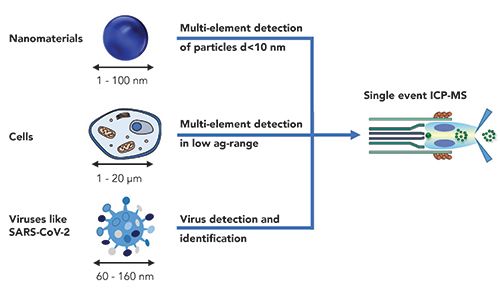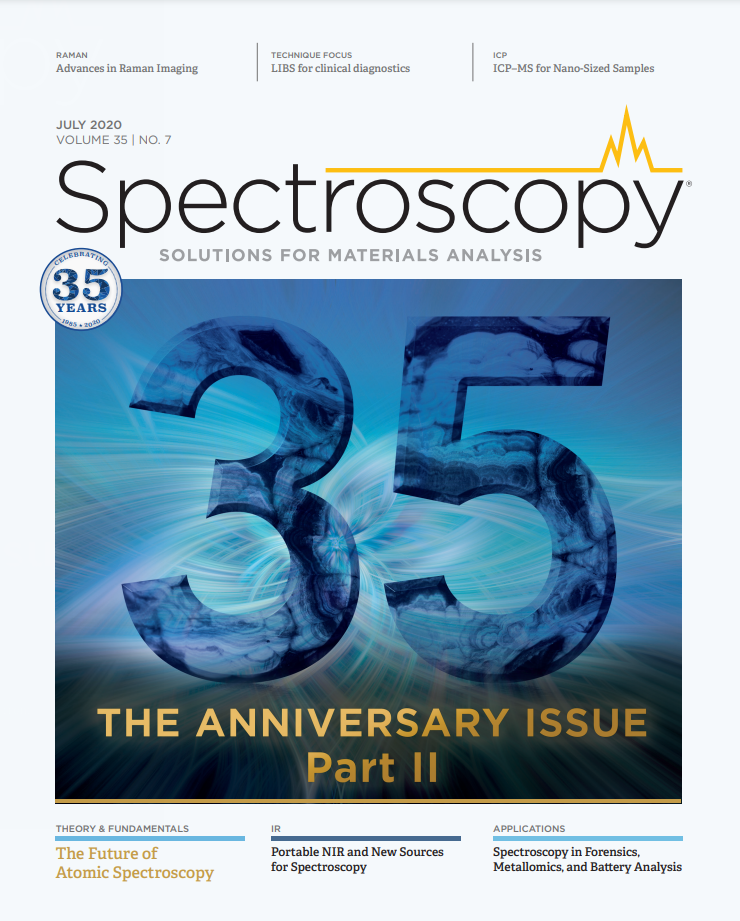When Size Matters: ICP-MS Detection of Small Objects
Spectroscopy
Nanomaterials have a tremendous impact on our daily life, but usually in a beneficial way because of their useful properties.
The world population is currently experiencing an enormous challenge fighting a pandemic that affects health, social, political, and socio-economic life of unforeseen dimensions. Responsible is a virus called SARS-CoV-2 with an approximate size between 60 and 160 nm. This size range is similar to that of nanomaterials, which are generally considered to have one or more external dimensions in the size range of 1 to 100 nm. Nanomaterials also have a tremendous impact on our daily life, but usually in a beneficial way because of their useful properties.
Metal-containing nanomaterials have been subject to various analytical efforts involving inductively coupled plasma–mass spectrometry (ICP-MS). Among other developments, a method originally described by Degueldre and coworkers in 2003 (1) is known as single particle ICP-MS (spICP-MS), and is based on a unique feature: The introduction of an individual particle into the ionization source produces a plume of ions of all the present elements within a very short time frame (<1 ms). This feature, combined with the use of short integration times, makes it possible to obtain the mass of one or more elements present in the particle (2). Many examples of the optimization and analysis of nanoparticles can be found, with particular emphasis on silver and gold nanoparticles of spherical shape. One aim of these studies is still the improvement of (size) detection limits, which is a major limitation of spICP-MS. With current instrumental capabilities, size detection limits below 10 nm (for spherical particles) are difficult to achieve, which is a significant limitation, particularly when taking into account industrially important materials like TiO2, FeOx, SiO2, and so on. These nanomaterials generally contain elements that experience strong interference in ICP-MS or are prone to contamination, or both. This limitation leaves an important gap for the general and broad range applicability of spICP-MS to the characterization of nanomaterials that fall under the general definition. In the case of composite particles and their complete characterization, the challenges are even greater (Figure 1). As discussed recently (2), several factors might improve achievable size detection limits in the future. These factors include the careful optimization of plasma parameters and detector integration times, as well as enhanced ion extraction and transmission. Overcoming such limitations would expand the already wide acceptance of spICP-MS.
Figure 1: Examples of the challenges for the detection of individual objects (nanoparticles, cells, and viruses) with ICP-MS.

A similar approach to spICP-MS was first described by Houk and coworkers for the analysis of individual bacterial cells (3) and is nowadays known as single-cell ICP-MS (scICP-MS). ScICP-MS is currently topic of great interest in elemental mass spectrometry, because it has been recognized that this technique can provide important quantitative data on intrinsic elements, the uptake of metal-containing drugs, and nanomaterials, and so on, with individual cell resolution. These data can be essential for nutritional, clinical, pharmaceutical, and toxicological studies. Moreover, pushed by the development of mass cytometry, more cellular parameters are accessible by the use of metal-tagged antibodies that can bind to intracellular or extracellular antigens of interest (4). Such a workflow allowed us recently to count the absolute number of a cellular surface biomarker (transferrin receptor 1, TfR1) in an individual cell, and was demonstrated on different cell lines (5).
The working principle is basically the same as in spICP-MS, but sample handling is more critical because of the vulnerability of living organisms. Various investigations are directed at obtaining sample introduction improvements to guarantee a high transport efficiency of intact cells into the ionization source. This is indispensable in the case of delicate or precious samples and significantly improves statistics on the elemental distribution in the studied cells. But as in the case of spICP-MS, achievable detection limits still restrict our ability to gain insights into the quantitative multi-element composition of individual cells. This evokes the vision of Professor Gary M. Hieftje of Indiana University for “all the ions all the time,” but such a development still remains a challenge for future ICP-MS instrumentation (Figure 1).
Bridging the detection capabilities of an ICP-MS instrument to a nanoscopic biological object like a virus seems hypothetical. Comparing the average dimensions of a biological cell and that of a virus, one can estimate roughly that a virus might contain only several hundred or several thousand atoms of constitutive elements. ICP-MS detection of such low absolute quantities in the presence of a high natural background of these elements might remain a dream for a long time. But the current pandemic situation makes it more than obvious that reliable, fast, and high-throughput tests are urgently needed for viral detection (Figure 1). Here might lie an opportunity for methodological developments, given that ICP-MS detection of individual objects clearly meets these prerequisites. Different labeling and amplification strategies might stimulate the development of an ICP-MS–based virus detection and identification kit that surely would further boost the prominence and relevance of elemental mass spectrometry.
Acknowledgements
The authors' research is funded by several organizations and institutions. We gratefully acknowledge financial support received from the government of Asturias through the Science, Technology, and Innovation Plan (PCTI) cofinanced by FEDER funds (ref. FC-GRUPIN-IDI/2018/000242) and from the Spanish Ministry of Economy, Industry, and Competitiveness (MINECO) through projects CTQ2016-80069-C 2-1R and RTI2018-094605-B-I00. Thermo Fisher Scientific (Bremen, Germany) and Teledyne Cetac Technologies (Omaha, Nebraska, USA), are acknowledged for instrumental support.
References
- C. Degueldre and P.-Y. Favarger, Colloids Surf. A 217, 137–142 (2003).
- D. Mozhayeva and C. Engelhard, J. Anal. At. Spectrom. DOI: 10.1039/c9ja00206e (2020).
- F. Li, D.W. Armstrong, and R.S. Houk, Anal. Chem. 77, 1407–1413 (2005).
- S.C. Bendall, E.F. Simonds, P. Qiu, E.D. Amir, P.O. Krutzik, R. Finck, R.V. Bruggner, R. Melamed, A. Trejo, O.I. Ornatsky, R.S. Balderas, S.K. Plevritis, K. Sachs, D. Pe’er, S.D. Tanner, and G.P. Nolan, Science 332, 687–696 (2011).
- M. Corte-Rodríguez, E. Blanco-González, J. Bettmer, and M. Montes-Bayón, Anal. Chem. 91, 15532–15538 (2019).

Mario Corte-Rodriguez is the Sara Borrell postdoctoral researcher, Maria Montes-Bayón is a full professor, and Jörg Bettmer is an Associate professor, all in the Department of Physical and Analytical Chemistry and the Instituto de Investigación Sanitaria del Principado de Asturias (ISPA) at the University of Oviedo, in Oviedo, Spain. Direct correspondence to bettmerjorg@uniovi.es

Trending on Spectroscopy: The Top Content of 2024
December 30th 2024In 2024, we launched multiple content series, covered major conferences, presented two awards, and continued our monthly Analytically Speaking episodes. Below, you'll find a selection of the most popular content from Spectroscopy over the past year.
Best of the Week: Hyperspectral Imaging, ICP-MS Analysis of Geological Samples, Product Roundup
October 18th 2024Top articles published this week include an article about hyperspectral imaging in human skin research, a peer-reviewed article about analyzing geological samples using atomic spectroscopy techniques, and an equipment roundup piece about the latest products in the industry.